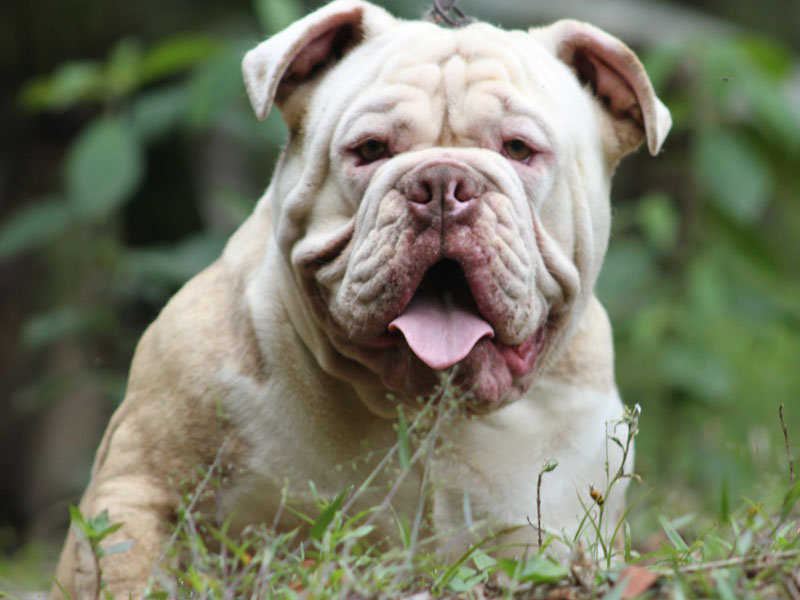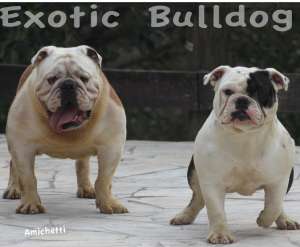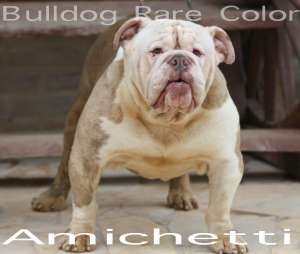A very big thank you Amichetti kennel
ENGLISH BULLDOG FEEDING
 A frequent question we always receive from our clients has to do with the type of food and feeding technics we provide to our English bulldogs. It is very important to keep in mind that English bulldogs are somewhat different to most breeds, and the fact that correct feeding technics are of utmost importance during and after their full development.
A frequent question we always receive from our clients has to do with the type of food and feeding technics we provide to our English bulldogs. It is very important to keep in mind that English bulldogs are somewhat different to most breeds, and the fact that correct feeding technics are of utmost importance during and after their full development.
Your English bulldog puppy does not know anything about nutrition. He only knows what tastes good. It is up to you to know what and how to feed your buddy so he will get everything he needs to stay healthy and happy.
Nutrients Necessities
Your English bulldog puppy needs proteins, carbohydrates, fats, vitamins and minerals for uptime growth and health.
Proteins are used for growth and repair of muscles, bones and other bodily tissues. They are also used for production of antibodies, enzymes and hormones.
Carbohydrates are metabolized into glucose, the body’s principal energy source.
Fats are also used for energy, along with hormone production, nervous system function and vitamin transport.
Vitamins and minerals participate in muscle and nerve function, bone growth, healing, metabolism and fluid balance.
English bulldogs also need plenty of fresh, clean water. Adequate water intake also helps prevent formation of urinary stones, which is potential problem for this breed.
At WB English bulldogs we recommend to new English bulldog families to continue to provide the same type of food the breeder was using prior to the release of the puppy. In our case we like to use Taste of the Wild (LAMB). We have used several other brands over the years and so far taste of the wild (LAMB) has worked great for our puppies and adults.
When feeding our English bulldog puppies for sale, we take into consideration things such as the amount of protein and fat they should receive in the first few weeks of age. There are other brands in the market that may provide the same or at least close to the same amount of protein and fat but important things such as ingredients of the food, allergies it might cause, as well as the amount of waste the dog will produce along with the characteristic gas passing “feature” that comes standard with this breed are things that one should always keep in mind when selecting the food you want to feed your new English bulldog puppy.
As professional breeders of English bulldogs we always let our clients know about the food we give to our puppies as well as other supplements that we use so that new owners of the English bulldog puppies can continue with the same process; but we do understand that a lot of times people may decide to change both the type of food and feeding technics based on what they may consider it is correct or better for their English bulldogs or perhaps after receiving veterinarian advise.
For those of you who have decided to continue to use Taste of the wild we do make emphasis that the one type we feed our
English bulldog puppies is labeled as taste of the wild (LAMB) .
The number of times you feed an English bulldog puppy is also very important. The younger the puppy is the more often one has to feed the puppy. For breeders it is a lot of work due to the fact that we have to care for the puppies since day one, feeding them at least every two (2) hours. By the time we usually release our English bulldog puppies to their new loving families the puppies will be at least eight (8) weeks old and they will be eating solid food. At this stage it is recommended to feed the puppies three (3) times a day; once in the morning, afternoon, and early evening. Sometimes due to a matter of schedule or advise from friends, breeders or veterinarians; families will feed the puppy two (2) times a day which will make things a little bit easy for the family training the English bulldog, and if this is the case the correct amount of food should be provided to the puppy based on their body weight as well as the age of the puppy. A feeding guide or table should be available to you on the bag of food you use.
In most cases it is recommended for an English bulldog to be on the puppy formula for the first year of life and then a gradual change to an adult formula containing the same nutrients should be given.
It is important to keep in mind that if you as an English bulldog puppy owner encounter any issues with your dog such as allergies or other common illnesses among bulldogs then veterinarian advise should be taken.
Supplements:
Why should you provide supplements to your English bulldog if the food has all they need?
There is no doubt that using a premium food to feed your English bulldog puppy is the smart thing to do. This food will provide the puppy with the nutrients needed to have a long healthy life, but as breeders we use other things to supplement the diet of our English bulldogs so that we can keep them away as much as possible from common illnesses among them.
The use of the right type of supplements from an early stage in the development of the dog is key when raising English bulldogs than with a lot of other breeds. This is due to the fact that English bulldogs have a weaker skeletal system and a lower immune system than other breeds. Having the presence of supplements will help the puppy to develop into a healthier adult.
Ester Vitamin C is a great supplement to give English bulldogs since it will help make the joints stronger and help with the very common illness such as “Hip Dysplasia”. Eggs, cod liver oil, chicken breast, some vegetables are also great for them.
Along with the food we use we also recommend the multi vitamin NuVet, which is a human grade product, made with natural ingredients. It helps with a lot of the common issues the English bulldog breed encounters during their life. For detail information on NuVet and how to order instructions please visit our website and click on the link on top that says NuVet.
If you think you still have questions about the right food to feed your English bulldog puppy or the correct supplement or multi vitamins you can use; please feel free to contact us. Remember that English bulldogs are the best breed in the world; therefor quality food, treats and supplements are ideal when having them as pets.
ENGLISH BULLDOG BEHAVIOR
English bulldog puppies do not have as many behavioral issues as many other breeds. This is why we insist English bulldogs are the best breed in the world; but by no means we are saying they can not enable a behavior that can be undesirable for the new puppy owner. The most common issue families encounter is the propensity for chewing which can be corrected by directing the puppy towards his chew toys.
It can be very frustrating when you have an English bulldog that has one or more behavioral issues; but the most important thing is to remember that the puppy does not know you don’t like that behavior. Once you realize the fact that your new puppy thinks he is acting normal then you can put your frustration aside so that you can see what is causing that behavior and be able to take the steps necessary to change it.
There are several reasons why a dog may engage in undesirable or destructive behavior. Some of those reasons can be:
lack of attention, interesting smells that make them dig, they get bored, they start teething, or get affected by stress etc.
A lot of times bulldogs may show signals that may indicate a bad behavior but often this happens when the dog feels lonely, ignored, neglected or simply no training has been provided by the owners. Other things that cause an unexpected change in behavior can be:
Health issues: A lot of times when they feel ill, in pain, or experience a psychological event; dogs can start acting out. It is important to receive veterinarian feed back if you notice a sudden change in your dog’ behaivor.
Bad diet: Keep in mind that English bulldogs need a good combination of carbohydrates, proteins, and minerals. If the puppy or adult bulldog is receiving too much or too little of one of this categories a change in the activity level may occur specially if you use sugars and starches as part of the diet of your pet.
Exercise: Even though English bulldogs are part of the non- sporting breed group and their activity level is quite low; we recommend that your bulldogs receives daily exercise. With adults, walking around the block will help, and with puppies playtime with the family is the best. This will prevent the puppy or adult to become bored and to start engaging destructive behaviors.
Lack of Leadership: As you may know English bulldogs are somewhat stubborn and tend to do things their way. Some times they even start acting out because they think they are their own masters and even yours too. It is of utmost importance to show the bulldog who is the pack leader to prevent an unwanted behavior. Keep in mind that taking the role as pack leader should happen immediately after your bring an English bulldog puppy home for the first time but in case you are having difficulties with your older bulldog it is never too late to start.
The term "Bulldog" was first mentioned in literature around 1500, the oldest spelling of the word being Bondogge and Bolddogge. The first reference to the word with the modern spelling is dated 1631 or 1632 in a letter by a man named Preswick Eaton where he writes: "procuer mee two good Bulldogs, and let them be sent by ye first shipp".[9] In 1666, English scientist Christopher Merret applied: "Canis pugnax, a Butchers Bull or Bear Dog", as an entry in his Pinax Rerum Naturalium Britannicarum.[10]
The designation "bull" was applied because of the dog's use in the sport of bull baiting. This entailed the setting of dogs (after placing wagers on each dog) onto a tethered bull. The dog that grabbed the bull by the nose and pinned it to the ground would be the victor. It was common for a bull to maim or kill several dogs at such an event, either by goring, tossing, or trampling. Over the centuries, dogs used for bull-baiting developed the stocky bodies and massive heads and jaws that typify the breed as well as a ferocious and savage temperament. Bull-baiting, along with bear-baiting, reached the peak of its popularity in England in the early 1800s until they were both made illegal by the Cruelty to Animals Act 1835. This amended the existing legislation to protect animals from mistreatment and included (as "cattle") bulls, dogs, bears, and sheep, so that bull and bear-baiting as well as cockfighting became prohibited. Therefore, the Old English Bulldog had outlived its usefulness in England as a sporting animal and its active or "working" days were numbered. However, emigrants did have a use for such dogs in the New World. In mid-17th century New York, Bulldogs were used as a part of a citywide roundup effort led by Governor Richard Nicolls. Because cornering and leading wild bulls were dangerous, Bulldogs were trained to seize a bull by its nose long enough for a rope to be secured around its neck.[11] Bulldogs as pets were continually promoted by dog dealer Bill George.[12]
Despite slow maturation so that growing up is rarely achieved by two and a half years, Bulldogs' lives are relatively short. At five to six years of age they start to show signs of aging.
In time, the original old English Bulldog was crossed with the pug. The outcome was a shorter, wider dog with a brachycephalic skull. Though today's Bulldog looks tough, he cannot perform the job he was originally created for as he cannot withstand the rigors of running and being thrown by a bull, and also cannot grip with such a short muzzle.
The oldest single breed specialty club is The Bulldog Club (England), which was formed in 1878. Members of this club met frequently at the Blue Post pub on Oxford Street in London. There they wrote the first standard of perfection for the breed. In 1894 the two top Bulldogs, King Orry and Dockleaf, competed in a contest to see which dog could walk 20 miles (32 km). King Orry was reminiscent of the original Bulldogs, lighter boned and very athletic. Dockleaf was smaller and heavier set, more like modern Bulldogs. King Orry was declared the winner that year, finishing the 20-mile (32 km) walk while Dockleaf collapsed.[13] The Bulldog was officially recognized by the American Kennel Club in 1886.[4]
At the turn of the 20th century, Ch. Rodney Stone became the first Bulldog to command a price of $5,000 when he was bought by controversial Irish American political figure Richard Croker.
TRICOLOR GENE MUSCLE BULLY
Amichetti Kennel
Facebookhttps://www.facebook.com/profile.php?id=100006118369229
Youtube https://www.youtube.com/channel/UCWTOIIFQdl7oSCLpZJWaDjA
Contato info@petclube.com.br / amichettibully@gmail.com
Google+https://plus.google.com/u/0/+ClaudioAmichettiPetclube
whatssapp 11 99386-8744 hc Amichetti / 11 96393-1128 hc Dr. Gabriel
Google https://plus.google.com/u/0/collection/cSD0CB
Blog petclube-amichetti.blogspot.com.br/p/american-bully-pitbull-pocket-blue-nose_19.html

